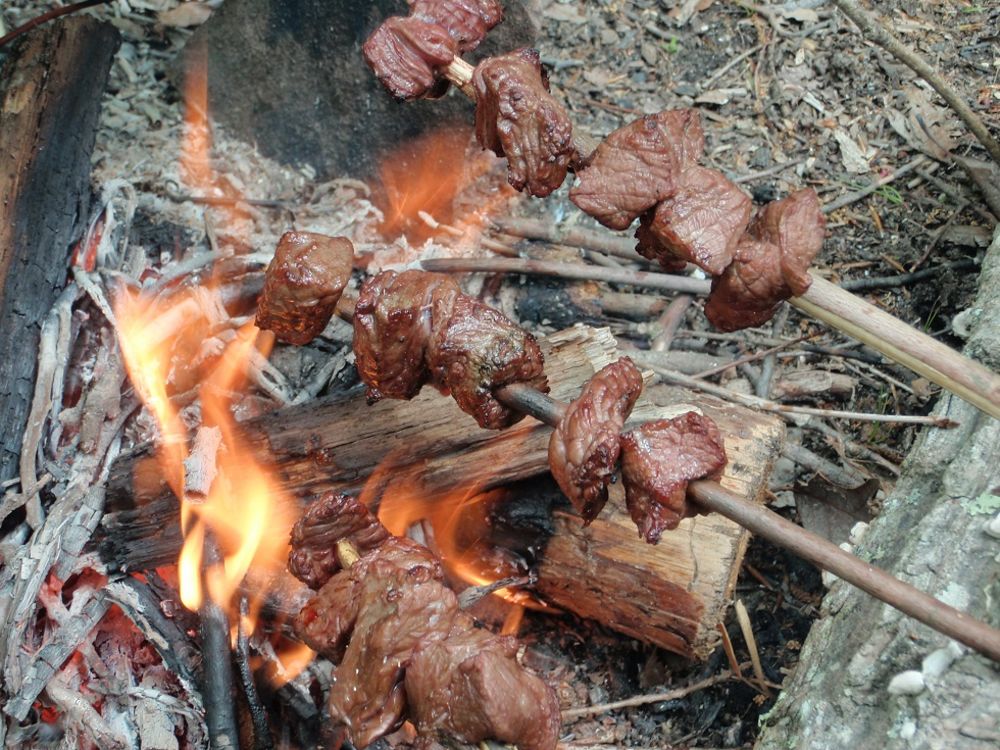In the aftermath of a survival incident, being able to cook the supplies you have stored can present a challenge.
That does not have to be the case as long as you have one key ingredient – fire – and use a little resourcefulness.
Make Ash Cakes
Out of bread? No oven to cook in? The coals of a campfire can bake up some tasty bread—if you have the secret ingredient to make your dough. When I started experimenting with camp breads years ago, I naturally turned to classic outdoor texts to find the recipes for bannock, damper, hard tack and every other kind of camp bread and trail biscuits you’ve heard about. The recipes themselves were simple enough. But these simple ingredients didn’t leave much room for error, and usually yielded something closer to ceramics than a biscuit.
After a few more fiascos, I finally stumbled upon pancake mix. The “just add water” complete pancake mix was the bread recipe that I had been hoping to find. It both tastes good, and it cooks quickly. Just add enough water to make a dry dough, pat out little “cookie” shaped patties, and toss them in the coals. Watch it closely as it starts to fluff up. You’ll cook it about one or two minutes on one side, depending on the heat of the coals. When it becomes rigid (like a little flat biscuit), and the very bottom edge begins to brown – use a stick to flip the cake over and cook it for another 30 to 60 seconds.
Cooking with Foil
A simple sheet of foil can become an oven, broiler, frying pan and many other vehicles for cooking—all you need is some food and a cooking fire. This is a big step up from baking your food directly in the ashes or coals of a fire, and foil pouches can make some great tasting meals over a bed of coals. Here are some tips:
— Use heavy duty foil, if it’s available.
—Fold packets up tightly if you’d like to keep the steam in.
—Leave a gap in the package if you need some steam to escape.
—Place the packet on a dying coal bed, not one that is too hot or filled with flames.Roasting with Spits and Skewers
Spits and skewers are a great way to roast small or medium cuts of meat, while grills are ideal for cooking larger chunks and even heavy roasts. Metal or fresh-cut “green” wood skewers and spits are one of the easiest methods of cooking directly over a fire. Cooking directly over the fire with skewers, spits and grills can give you a much better result than just placing food directly on a bed of coals, and it gives you greater control of fire temperatures as you can build up or tone down the fire.
You can also control the height of the food from the fire to determine the cooking temperature and time.
Tips for cooking directly over a fire with wood skewers, spits and grills:
—The fire should have a good bed of coals and be fed with hardwoods if possible.
— Softwoods burn quickly and some resinous ones like pine make harsh, unpleasant tasting smoke.
—The wooden skewers, spits and grills must be green, non-toxic wood. If the wood is dead it will burn up and drop the food. Metal skewers and spits should be non-toxic metal.Skillets and Griddles
Skillets, frying pans, griddles and improvised frying containers can allow you to make very tasty meals, often resembling home-cooked favorites. Bricks, stones, cinderblocks or other fire-proof supports can do a great job suspending a frying pan or griddle over a small fire.
These supports will allow you to cook if they are only 6 inches tall, but one foot tall supports will work much better. Here are some tricks to try:
— Use small dry sticks and split wood pieces to keep flames under your pan.
—Pour a spoon full of water in the pan or on the griddle to see if it’s level.
—If it isn’t level, add small thin stones or other non-flammable objects to level it.
—These can be temporary set-ups or semi-permanent fixtures.
Getting a hot meal inside of you in a survival situation carries a lot of benefits.
The obvious benefit is nutrition, but a hot meal also distracts from your surroundings and it improves morale – that is why they call it “comfort food!”
To learn other survival cooking methods, check out Outdoor Life!
Featured Image via Tim MacWelch/Outdoor Life

Cooking with hot stones is another method .
Dig a hole , build a fire in hole, put on large logs on fire , let fire die down , put stones on top of fire , put food on stones , cover food with more stones , cover stones with earth/ leaves . Leave to cook for several hours then unearth food & eat . I think it’s called a Hawaiian oven but not too sure .
MyPhu Phair Ryan Reilly
I was taught about survival and bush craft since I was a kid, the food was often so bad that I became a chef lol
For some reason I find any meat cooked over an open is fantastic